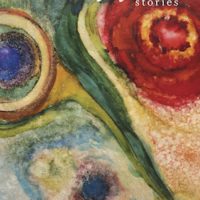In the opening story of Margaret Luongo’s collection History of Art, a woman is placed in a locked room by a captain of the military. “The War Artist” is given a uniform and art supplies, with the expectation that she make art about war. Right away, this sequestered artist feels she is in over her head:
She had told the children it was an honor to serve as the nation’s war artist, that she owed it to the soldiers to do a good job. The weight of her new responsibility—to make the war comprehensible to those who couldn’t witness it—exhausted her.
As she struggles with her task, experimenting in different mediums, the sights and sounds of the war enter the room—gunfire, sirens, the cries of victims—culminating in a swirling sandstorm:
When the storm ended, everything in the room was coated with a layer of the finest sand she’d ever felt. Everything she touched was coated in grit… Eventually, the sand infiltrated all of her inks and paints so that everything she made contained it: the portraits of her husband and children that she drew from memory; the lakeside landscape of her family’s summer home; a still life of her children’s lunch bags and schoolbooks.
She toils on. Eventually, the higher-ups send in a translator, but his interactions with the artist are complicated and rife with misunderstanding. A general arrives and the artist wonders, after her labored efforts, how her art has been received outside the room.
The war artist felt a roiling burn at the base of her throat. ‘What did you learn?’
The general suppressed a smile. ‘You responded in interesting ways. We were touched by your… humanity. We admired your passion.’
In this surreal tale, Luongo introduces the primary concerns of these stories—the myriad of complications inherent to the creation and interpretation of art, and the destructive qualities of war.
Humans have a complex, fluctuating relationship to art and the artifacts that surround us. Luongo isn’t afraid to question the mutability of the object in relation to its owner or to ponder what distinguishes one man’s trash from another’s treasure. In “Repatriation,” a woman recalls a museum visit with her father, who has recently passed away.
The museum had emptied its storage facility and put on display every antiquity in its collection. She paused before one of the many glass cases, stunned by the sheer number of lead spoons, foggy glass vials, iron hairpins and makeup spatulas—millennia of refuse, lost or abandoned by humans as they pursued or fled one another across the globe.
‘Does this make you love or hate humanity more?’ her father had asked.
As she and her brothers sort through their father’s home, they’re unable to find the only truly interesting item he owned (in her estimation), a marble bust appropriated during the war. As a child, she would visit the bust where her father kept it hidden in a closet, and she’d ponder what meaning it held for him.
The world of Luongo’s stories is littered with items lost, broken, collected, and left behind. Great works of sculpture are missing noses or fingers; a father’s life is reduced to crates full of empty Schweppes cans and a collection of guns. Her characters bump around the living museum of existence, acting and reacting to objects, artistic and other. At times, Luongo’s machinations feel too overt, too over-worked. In “Magnolia Grandiflora,” a woman stagnates in her deceased parents’ home, surrounded by their belongings. Her husband’s possessions have been relegated to a carport, and most of their shared things have been discarded. This alone makes Luongo’s point about the pull and effect of objects, identity and legacy, but her character has also taken over her parents’ business settling estates:
I have auctioned entire households of furniture—secretaries stuffed with crinkled letters in foreign languages, pantries full of home-canned tomatoes, beans, cabbage, and soup… And over everything, the thick dust, the heavy, living smell of thriving mold and mildew. In my office, stacked in bookcases with glass doors, sit tins and leather albums of unlabeled family photographs and daguerreotypes.

If Luongo’s intention is to create a character entirely buried by objects, then she succeeds here. But there is also the matter of the woman’s sister, Janice, who has given her a teapot she doesn’t like, a symbol of the discord between the women. Janice also runs a small vocational agency that helps people—in a touchy-feely kind of way—find their life’s true calling. This is, of course, exactly what both Janice and her husband need. One or two of these thematic signals would have done; this story has them in excess.
The stories in History of Art vary in length and type; experimental offerings are peppered throughout. “Seeing Birds” reads like an instructive manual for fledgling bird-watchers (and perhaps, for artists):
Equipment
The only essential equipment for seeing birds is a pair of eyes.
Where to Look
In the woods behind your home, among the reeds around the drainage pond, in the trees that line the streets in your neighborhood…
How to Look
With your eyes, not your memory. Your memory can’t be trusted. You think you’ve seen birds, and maybe you have, but can you describe the last bird you saw?
“Word Problem” follows the lives and careers of ten conservatory students, in the form of an algebraic query. “Chinese Opera” is a very short—only seven paragraphs—remembrance of a cherished, ornate music box. “The Confused Husband,” an affecting, fable-like story that seems incongruous to the collection’s themes but was one of my favorites, opens thus:
He met the woman he was to marry, but she didn’t have a limp. The old witch who’d read his cards had said his wife would have a limp. He had understood the crone’s message: his bride, lovely and perfect in every other way, would have a malformed leg; his life would be one of hardship, working to support and care for her. He told the crone, It doesn’t matter. I’ll love her anyway. He felt very noble.
Any good allegory has a twist and this one doesn’t disappoint. When Luongo deals with human foible or pathos, her writing is wise and insightful. One of the longer, traditional stories, “Three Portraits of Elaine Shapiro,” tells the named character’s story from twenty-two to forty-two years of age. In the first “portrait,” Elaine is engaged to the wrong young man and decides on a drastically different course at someone else’s wedding in New York City. Up to this point, she has been indecisive and impressionable, a leaf floating down the river of life. And yet, a decade later, we find the same Elaine, having never lived up to her romantic notion of being a woman of independent means. At another dressy social event, she observes:
Every woman outfitted in pearls or diamonds or weighted down with gold had a man nearby, and each one held onto the arm of her man like an anchor. Elaine, in her slip of a dress and her miniscule earrings, felt in danger of floating away.
Elaine’s life effectively passes her by while she remains attached to notions of what she should do, or have, or feel. Many of Luongo’s characters suffer the pains of an anchorless existence, and the fleeting, unsubstantial traces likely to be left behind. These stories have much to say about art and art-making: the ways art can enter a life and infuse meaning, the absolute subjectivity of interpretation, the difficulties of transforming any experience into a translatable, sensory-receptive form. Anyone who has tried to create art will find much to appreciate on an intellectual level. But Luongo’s work really shines when she bridges the gap between concept and the more visceral connections that inspire empathy and understanding. The same could be said of art itself, and what makes it most alive.




